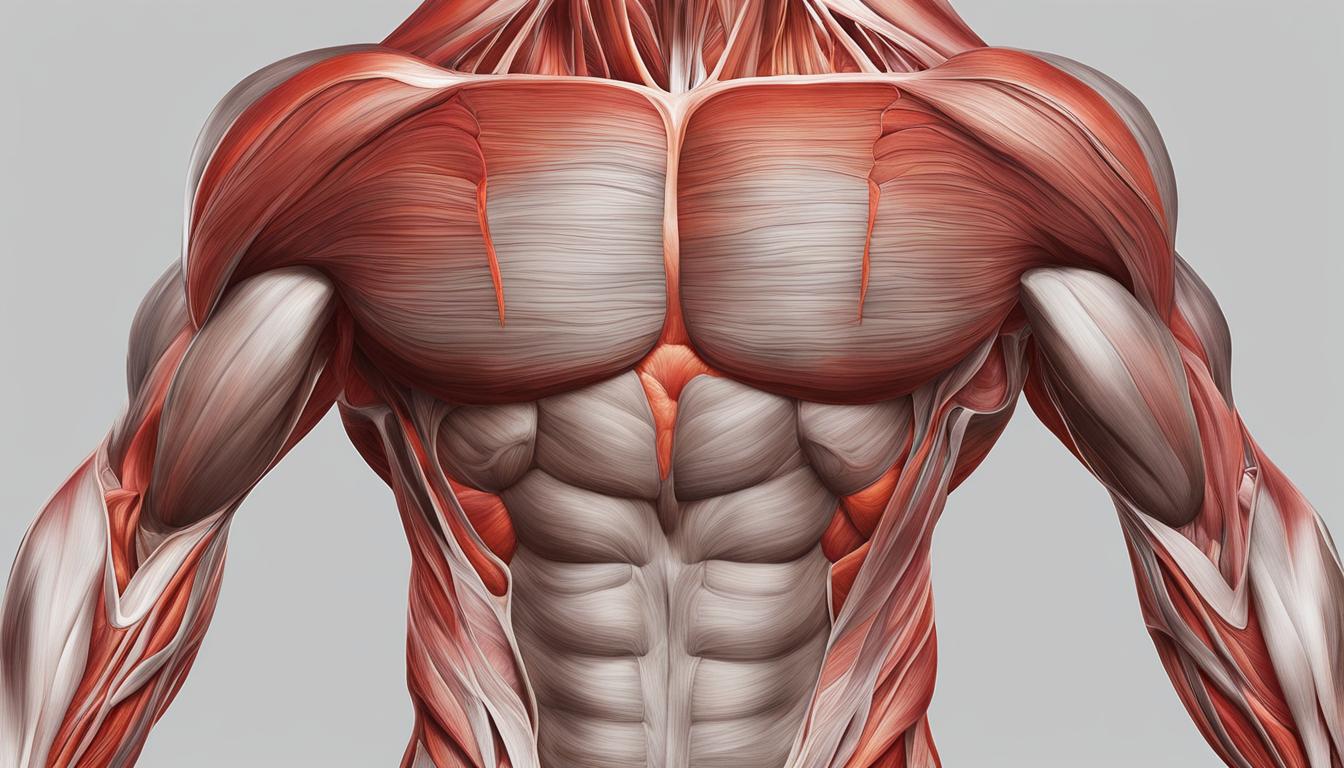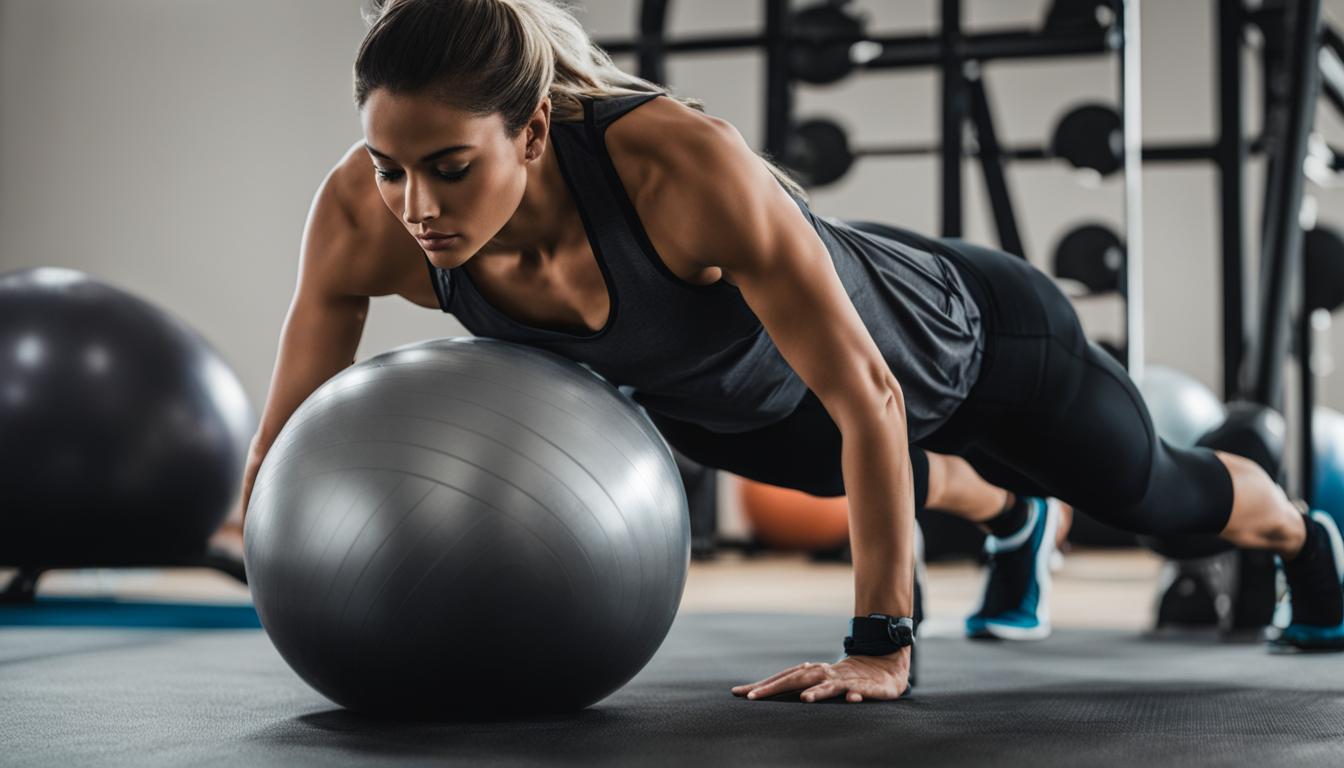A strong core is crucial for athletes looking to enhance their performance and prevent injuries. Core strengthening exercises target the muscles of the core, including the abdominals, back, and obliques, helping athletes improve their stability, strength, and overall athleticism.
Incorporating core exercises into a training routine can have numerous benefits. Core exercises strengthen the abdominal muscles, improving posture and reducing the risk of lower back pain. They also enhance rotational power, which is essential in sports like golf and tennis. By focusing on core strengthening exercises, athletes can optimize their physical fitness and excel in their respective sports.
Key Takeaways:
- Core strengthening exercises are essential for athletes to enhance performance and prevent injuries.
- These exercises target the muscles of the core, including the abdominals, back, and obliques.
- Incorporating core exercises into a training routine improves stability, strength, and overall athleticism.
- Core exercises strengthen the abdominal muscles, improve posture, and reduce the risk of lower back pain.
- Core strengthening exercises enhance rotational power, benefiting sports like golf and tennis.
Understanding the Importance of Core Strength
Having a strong core is essential for athletes. It provides the foundation for all movements and helps to stabilize the spine, pelvis, and kinetic chain during functional movements. A strong core not only enhances performance but also aids in injury prevention. By focusing on core strength, athletes can improve their overall physical fitness and excel in their respective sports.
The Anatomy of the Core
The core is a complex system of muscles that play a crucial role in stabilizing the spine, hips, and shoulder girdle. Understanding the anatomy of the core is key to targeted training and strengthening of these muscles.
One of the most well-known core muscles is the rectus abdominis, commonly known as the “six-pack.” This muscle runs vertically along the front of the abdomen and is responsible for flexion of the spine. It gives the abdomen its defined appearance and is often the focus of abdominal workouts.
The transverse abdominis is another important core muscle. It is a deep muscle that runs horizontally across the abdomen and acts as a natural corset, providing stability and support to the spine.
The internal and external obliques are located on the sides of the abdomen. The internal obliques run diagonally upward from the hip bone to the ribs, while the external obliques run diagonally downward from the ribs to the hip bone. These muscles play a significant role in trunk rotation and side bending movements.
Additionally, the quadratus lumborum, situated on either side of the lower back, helps stabilize the pelvis and spine. It plays a vital role in maintaining proper posture and spinal alignment.
An Illustration of the Core Muscles

Understanding the anatomy of the core allows athletes to target these specific muscles during their training routines. By incorporating exercises that engage the rectus abdominis, transverse abdominis, internal and external obliques, and quadratus lumborum, athletes can develop a strong and resilient core that improves stability, prevents injuries, and enhances overall athletic performance.
Different Planes of Core Motion
The core is involved in a variety of motions, which can be categorized into different planes. Understanding these planes of motion is crucial for targeting specific aspects of core strength and improving overall movement capabilities.
Sagittal Plane:
The sagittal plane refers to movements that occur in a forward/backward and up/down direction. This includes exercises like squats, lunges, and sit-ups. Training the core in the sagittal plane helps improve stability and strength during these types of movements.
Frontal Plane:
The frontal plane involves side-to-side movements. Exercises like lateral lunges and side planks target the core muscles in this plane. By training the core in the frontal plane, athletes can enhance lateral stability and develop a well-rounded core.
Transverse Plane:
The transverse plane is associated with rotational and twisting movements. Exercises like Russian twists and woodchoppers engage the core muscles in this plane. By incorporating movements in the transverse plane, athletes can improve rotational stability, agility, and power.
Training the core in all planes of motion is essential for developing a strong, stable, and functional core. By incorporating exercises that involve movements in the sagittal, frontal, and transverse planes, athletes can enhance their overall stability and performance in various sports and activities.
Core Strengthening Exercises in Different Categories of Movement
Core strengthening exercises encompass various types of movement to target different aspects of core strength and stability. Incorporating these exercises into your training routine can help enhance your overall performance and reduce the risk of injury. Let’s explore the different categories of movement and the exercises associated with each:
Flexion & Extension Exercises
Flexion and extension exercises involve movements that emphasize stretching and contracting the core muscles. Examples of flexion exercises include sit-ups and crunches, which work the rectus abdominis muscles. Extension exercises, such as supermans, focus on strengthening the muscles along the back of the core.
Lateral Flexion & Extension Exercises
Lateral flexion and extension exercises target side-to-side movements that engage the oblique muscles. These exercises help improve core stability and create a balanced strength along the lateral aspects of the trunk. Side bends and standing side crunches are effective exercises for lateral flexion and extension.
Rotation Exercises
Rotation exercises focus on enhancing the core’s rotational strength and mobility. These exercises mimic twisting movements, which are often required in sports and daily activities. Russian twists and seated trunk rotations are excellent exercises to incorporate into your routine for rotational strength.
Anti-Rotation Exercises
Anti-rotation exercises help build stability against rotational forces, enhancing core strength during movements where the body resists rotation. Planks with shoulder taps and cable chops are examples of anti-rotation exercises that help develop a strong and stable core.
Bracing Exercises
Bracing exercises, such as planks, focus on creating a stable core during dynamic movements. These exercises involve contracting the core muscles to create a solid foundation and resist movement. Planks, side planks, and variations like plank reaches are effective bracing exercises for core stability.
By incorporating a variety of core strengthening exercises from different categories of movement, you can target all aspects of core strength and stability. Remember to consult with a fitness professional to ensure proper form and technique during these exercises.
Core Strengthening Exercises from Source 1
When it comes to core strengthening, Source 1 recommends a variety of exercises that target different aspects of core strength and stability. Incorporating these exercises into your training routine can help build a strong and functional core, enhancing your athletic performance. Let’s take a look at five key exercises recommended by Source 1:
1. Supermans
The superman exercise focuses on trunk extension, helping to strengthen the muscles in your lower back. To perform this exercise, lie face down on the floor with your arms extended in front of you. Lift your arms, chest, and legs off the ground simultaneously while keeping your gaze down. Hold this position for a few seconds before lowering back down. Repeat for several repetitions.
2. KB Teapots
KB teapots target lateral flexion, working the muscles on the sides of your core. Start by holding a kettlebell in one hand and standing with your feet shoulder-width apart. With the kettlebell held at your side, lean your upper body to the opposite side. Return to the starting position and repeat on the other side. Perform several repetitions on each side to strengthen your lateral core muscles.
3. Lunge Banded Rotations
Lunge banded rotations are great for improving rotational stability. Begin by standing with your feet shoulder-width apart and holding a resistance band in front of you. Step forward with one leg into a lunge position while simultaneously rotating your upper body away from the front leg. Return to the starting position and repeat on the other side. Alternate between legs for a challenging core exercise.
4. Pallof Presses
Pallof presses are effective for strengthening anti-rotation. Stand perpendicular to a cable machine or resistance band anchor point, with your feet shoulder-width apart and your side facing away from the anchor. Grab the cable or resistance band with both hands and hold it at chest level. Extend your arms forward while maintaining a stable core and without allowing your body to rotate. Hold for a few seconds before returning to the starting position. Repeat for several repetitions.
5. Deadbugs
Deadbugs are fantastic for enhancing overall core control. Lie flat on your back with your arms extended towards the ceiling and your legs in a tabletop position. Slowly lower one arm and the opposite leg towards the ground while keeping your core engaged and your lower back pressed into the floor. Return to the starting position and repeat on the other side. Alternate sides for a challenging core exercise.
By incorporating these core strengthening exercises recommended by Source 1 into your training routine, you can target different aspects of core strength and stability. Remember to perform each exercise with proper form and consult with a fitness professional if you have any concerns or questions.
Core Strengthening Exercises from Source 2
When it comes to core strengthening exercises, Source 2 offers a range of innovative and effective options to challenge athletes. These exercises not only target the core muscles but also improve stability, strength, and coordination. Let’s explore some of the recommended exercises:
Plate Crunch
The plate crunch is a dynamic exercise that engages the abdominal muscles and challenges the core. It involves holding a weight plate against the chest while performing crunches, adding resistance and intensifying the exercise.
Hydro Weight Kayaking
Hydro weight kayaking is a unique exercise that combines the benefits of kayaking and hydro weights. By paddling against the resistance of the water, athletes can strengthen their core while improving their upper body strength and cardiovascular fitness.
Pass the Plate
Pass the plate is a fun and engaging exercise that requires coordination and core control. Athletes pass a weight plate from hand to hand, engaging the obliques and promoting rotational stability.
Hydro Weight Chop
The hydro weight chop is a powerful exercise that mimics the movement of chopping wood. It involves using a weighted object, such as a hydro weight or medicine ball, to perform diagonal chops, targeting the core, and enhancing rotational strength.
Hydro Weight / Barbell Bicycling
Hydro weight or barbell bicycling is a challenging exercise that combines the benefits of cycling with added resistance. Athletes can use hydro weights or barbells to simulate the pedaling motion while engaging the core and lower body muscles.
To see how these exercises are performed and learn more about their benefits, check out the image below:
“Incorporating these exercises from Source 2 into your core training routine can help you target your core muscles from various angles, enhancing your stability, strength, and overall athletic performance.”
By incorporating these core strengthening exercises from Source 2, athletes can diversify their training routine and challenge their core muscles in new and exciting ways. These exercises effectively target the core, promote stability, enhance strength, and improve coordination, allowing athletes to perform at their best in their respective sports.
Core Strengthening Exercises from Source 2 (continued)
Source 2 also recommends a set of core strengthening exercises that can further enhance your core strength and stability. These exercises target various aspects of core strength, including rotation, anti-rotation, and overall stability. Incorporating these exercises into your core workout routine can help you build a strong and functional core.
Glute Ham Ab Rotation
The glute ham ab rotation exercise is a challenging movement that targets your core muscles, particularly the obliques. To perform this exercise, start by lying face down on a glute ham developer machine with your feet secured. Place your hands behind your head and engage your core. Lift your upper body while simultaneously rotating towards one side, then return to the starting position. Repeat on the other side. This exercise helps improve rotary stability in the core.
Ironklad Abs
Ironklad abs focus on strengthening your entire core, including the abdominals, obliques, and lower back. Start by sitting on the ground with your knees bent at a 90-degree angle and feet lifted off the floor. Lean back slightly, engage your core, and straighten your legs while simultaneously rotating your torso towards one side. Return to the starting position and repeat on the other side. This exercise targets both rotational and anti-rotational strength.
Hanging Leg Raises
Hanging leg raises are an effective exercise for building core strength and stability. Begin by hanging from a pull-up bar with your arms fully extended. Engage your core and lift your legs towards your chest while maintaining control throughout the movement. Lower your legs back down to the starting position and repeat. This exercise primarily targets your lower abdominal muscles.
Dane’s Fast Abs
Dane’s fast abs is a dynamic core exercise that engages multiple muscle groups simultaneously. Begin in a push-up position, with your hands slightly wider than shoulder-width apart and your feet together. Keeping your body in a straight line, jump your feet forward towards your hands and then quickly jump them back to the starting position. This exercise combines core stability, explosiveness, and cardiovascular endurance.
Banded Hollow Body Rocks
Banded hollow body rocks are an excellent exercise for developing core stability and control. Start by lying on your back with a resistance band wrapped around your feet. Lift your legs off the ground while simultaneously crunching your upper body and reaching your hands towards your feet. Rock back and forth while maintaining tension in the band. This exercise targets your entire core, including the abdominals and lower back.
Core Strengthening Exercises from Source 3
In the realm of core training, Source 3 proposes a three-phase approach to optimize stability, strength, and performance: stability, strengthening, and chaos. Each phase serves a unique purpose in building a solid foundation of core strength and enhancing athletic ability. Let’s delve into each phase:
Stability Phase
In the stability phase, athletes focus on motor control, learning proper form and positioning to establish a strong base. This phase emphasizes exercises that promote stability and body awareness, such as planks, bird dogs, and pelvic tilts. By developing stability, athletes lay the groundwork for more advanced strengthening exercises.
Strengthening Phase
Once stability has been established, athletes progress to the strengthening phase, which introduces more challenging exercises to increase muscle strength and endurance. This phase involves utilizing eccentric tempos and incorporating isometric pauses to intensify the movements. Examples of exercises in this phase include weighted carries, hanging leg raises, and Russian twists. The strengthening phase allows athletes to develop the necessary core strength to excel in their chosen sport.
Chaos Phase
The chaos phase is the final stage of the core training progression. It focuses on transferring the gained stability and strength to unpredictable sport-specific situations. Athletes engage in exercises that challenge their core stability and balance, such as instability ball exercises, medicine ball throws, and dynamic plank variations. By training in chaotic environments, athletes can enhance their ability to maintain stability and control during complex movements encountered in sports.
By following this three-phase approach, athletes can build a solid foundation of core strength, improving their stability, power, and overall performance. Incorporating stability, strengthening, and chaos phases into their training routine will help athletes reach their full potential on the field or court.

Building a Blueprint for Core Training
When structuring core training, it’s important to consider anti-movement patterns. These include anti-flexion and extension, anti-flexion lateral, and anti-rotation. By training the core in these patterns, athletes can develop stability, strength, and resilience against various forces and movements. Incorporating exercises that target these anti-movement patterns is crucial for a well-rounded core training program.
One way to structure core training is by utilizing a three-phase approach: stability, strengthening, and chaos. In the stability phase, athletes focus on motor control, proper form, and positioning. This phase lays the foundation for core strength and stability. The strengthening phase increases the intensity of the exercises, incorporating eccentric tempos and isometric pauses to further challenge the core muscles. Finally, in the chaos phase, athletes transfer their core strength and stability to unpredictable sport-specific situations.
By training the core in these different phases and targeting anti-movement patterns, athletes can optimize their performance and reduce the risk of injury. Incorporating exercises such as planks, bird dogs, side planks, Russian twists, and wood chops can help develop anti-flexion and extension, anti-flexion lateral, and anti-rotation strength respectively.
Furthermore, it’s important to note that core training should be complemented with exercises that focus on other muscle groups as well. The core muscles do not work in isolation, and a comprehensive training program should include exercises that target the entire body.

Conclusion
Core strengthening exercises are crucial for athletes of all levels to improve their performance and prevent injuries. By incorporating a variety of exercises that target different aspects of core strength, athletes can enhance their stability, strength, and overall athleticism. A strong and functional core provides a solid foundation for all movements, helping athletes excel in their respective sports.
In addition to boosting performance, a strong core also plays a vital role in injury prevention. By strengthening the muscles of the core, such as the abdominals, back, and obliques, athletes can better stabilize their spine, pelvis, and kinetic chain during functional movements. This increased stability reduces the risk of common sports-related injuries.
To optimize the benefits of core strengthening exercises, it is important to include a variety of exercises in a training routine. This ensures that all aspects of core strength, stability, and strength are addressed. Whether it’s flexion and extension exercises, rotational movements, or anti-rotation exercises, athletes should strive for a balanced and comprehensive approach to core training.
By consistently integrating core strengthening exercises into their workouts, athletes can reach their full potential and achieve optimal performance in their chosen sports. Whether they are professional athletes or fitness enthusiasts, focusing on core strength will not only improve their athletic abilities but also contribute to their overall physical fitness and well-being.
FAQ
Why are core strengthening exercises important for athletes?
Core strengthening exercises are crucial for athletes to enhance their performance and prevent injuries. These exercises target the muscles of the core, including the abdominals, back, and obliques. By incorporating these exercises into their training routine, athletes can improve their stability, strength, and overall athleticism.
What is the importance of core strength for athletes?
Having a strong core is essential for athletes. It provides the foundation for all movements and helps to stabilize the spine, pelvis, and kinetic chain during functional movements. A strong core not only enhances performance but also helps prevent injuries. By focusing on core strength, athletes can improve their overall physical fitness and excel in their respective sports.
Which muscles make up the core?
The core is composed of various muscles, including the rectus abdominis (six-pack muscles), transverse abdominis, internal and external obliques, quadratus lumborum, and more. Each of these muscles plays a role in stabilizing the spine, hips, and shoulder girdle. Understanding the anatomy of the core is important for targeted training and strengthening of these muscles.
In what planes of motion does the core work?
The core works in different planes of motion. The sagittal plane involves movements in a forward/backward and up/down direction. The frontal plane involves side-to-side movements. The transverse plane involves rotational and twisting movements. By training the core in all planes of motion, athletes can improve their overall stability and movement capabilities.
What are the different categories of core strengthening exercises?
Core strengthening exercises can be categorized into different types of movement. These include flexion & extension exercises, which involve movements like sit-ups and supermans. Lateral flexion & extension exercises target side-to-side movements. Rotation exercises focus on rotational movements, while anti-rotation exercises help build stability against rotational forces. Bracing exercises, such as planks, help create a stable core during dynamic movements.
Which core strengthening exercises are recommended by Source 1?
Source 1 recommends five core strengthening exercises for athletes. These exercises are supermans, KB teapots, lunge banded rotations, Pallof presses, and deadbugs. Each exercise targets different aspects of core strength and stability. Supermans focus on trunk extension, KB teapots target lateral flexion, lunge banded rotations work on rotational stability, Pallof presses strengthen anti-rotation, and deadbugs enhance overall core control.
What core strengthening exercises are suggested by Source 2?
Source 2 recommends ten core strengthening exercises for athletes. These exercises include plate crunches, hydro weight kayaking, pass the plate, hydro weight chop, hydro weight, and barbell bicycling. These exercises offer a unique and challenging way to target the core and improve stability, strength, and coordination.
What other core strengthening exercises are suggested by Source 2?
Source 2 also suggests glute ham ab rotations, Ironklad abs, hanging leg raises, Dane’s fast abs, and banded hollow body rocks as effective core strengthening exercises. These exercises target different aspects of core strength, including rotation, anti-rotation, and overall stability. Incorporating these exercises into a core workout routine can help athletes build a strong and functional core.
What is the three-phase approach to core training proposed by Source 3?
Source 3 proposes a three-phase approach to core training: stability, strengthening, and chaos. The stability phase focuses on motor control and teaching proper form and positioning. The strengthening phase increases the intensity of the exercises and includes eccentric tempos and isometric pauses. The chaos phase aims to transfer core strength and stability to unpredictable sport-specific situations. By following this progression, athletes can develop a solid foundation of core strength and improve their performance in sports.
How can anti-movement patterns be incorporated into core training?
When structuring core training, it’s important to consider anti-movement patterns. These include anti-flexion and extension, anti-flexion lateral, and anti-rotation. By training the core in these patterns, athletes can develop stability, strength, and resilience against various forces and movements. The training modality can be divided into stability, strengthening, and chaos phases, with each phase targeting specific goals and exercises. By implementing a well-rounded core training program, athletes can optimize their performance and reduce the risk of injury.
Why are core strengthening exercises essential for athletes?
Core strengthening exercises are essential for athletes of all levels. By incorporating exercises that target different aspects of core strength, athletes can enhance their stability, strength, and overall performance. A strong and functional core not only improves athletic performance but also helps prevent injuries. Including a variety of core strengthening exercises in a training routine can help athletes reach their full potential and excel in their respective sports.


